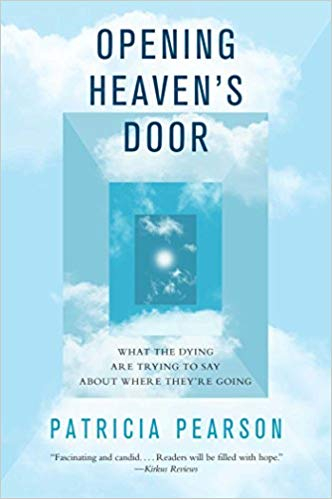
Opening Heaven’s Door is the result. In it Pearson surveys phenomena which suggest the continuation of some kind of consciousness, interweaving her research and interviews with her own anecdotes, giving her journey a personal aspect lacking in technical academic texts. Her approach makes discussion of the issues more digestible for the interested person who does not want to wrestle with the specialised literature. She covers a range of issues relevant to the consideration of the survival of bodily death, such as deathbed visions, or ‘Nearing Death Awareness’, including terminal lucidity, shared (between living and dying) death visions and the highly significant ‘Peak in Darien’ cases in which a dying person recounts seeing someone who has died but of whose parting they were unaware; apparitions; dreams and visions of the living that coincide with someone’s death; the sense those in extreme peril often have of a guiding force coming from outside themselves; and of course Near-Death Experiences, the topic with the highest profile in the field today.
In the process she shows how common these various phenomena are, but not much talked about by either those who have them or those who witness others having them, because people do not want to be tagged as hysterical, delusional, or weak-minded. In a society where ‘letting go’ is prized for mental health, talking about connections with the afterlife comes to seem pathological. She recounts a conversation at a party in which she discussed her sister’s experience the night their father died, and was shocked at how easily it was attributed to imagination, with no attempt to consider whether there was some factor that could not be reduced to a chance correlation. By contrast she finds the sorts of theories couched in terms of hallucinations, wishful thinking, anoxia and other by-products generated by a dying brain to ease the transition to extinction to be inadequate as explanations. End-of-life experiences and those reported by people who have undergone an NDE possess a coherence and vividness not exhibited by the fragmentary imagery caused by lack of oxygen or administration of drugs.
However, the secrecy that has surrounded these experiences in the past is giving way as those who have undergone them are becoming more willing to speak out than they used to be and more research is published, attaining a higher profile in the media. The result is an ever-expanding database, and complex theoretical debates, that have generated a rich body of data that can be daunting to the newcomer. That it can still be difficult to speak out is indicated by Pearson herself, when she recounts how she saw a platform medium who gave a series of messages highly relevant to her that seemed to come from her late sister, but which she found she could not acknowledge in public.
The book is very readable, though Pearson perhaps foregrounds the personal angle more than is necessary. What is lacking in her journalistic approach is the depth that comes from a thorough familiarity with the literature beyond that which meets her immediate needs. For example she refers to Sir William Barrett simply as a physicist in Dublin, and suggests that he wrote his classic 1926 book Death-Bed Visions because of a case that his wife had drawn to his attention in 1924 (it appears in the December 1924 issue of the SPR’s Journal, ‘A Remarkable Case of Vision of the Dying’). She does not indicate what a significant figure he had been more generally as a psychical researcher during the preceding half century. The SPR itself barely rates a mention.
There is no new research here, but it is a useful survey that makes an accessible introduction and anyone interested enough to read this will have a good foundation to go into the topics Pearson covers in more detail. It is possible that much of the evidence she presents can be explained in terms of normal, if unusual, processes, but to reflexively dismiss such experiences as ‘woo’, as so often happens, is inimical to healthy debate. Many possess a dimension that on the face of it seems to indicate something extraordinary is occurring. It is the type of experience that suggests some psi element at work which particularly deserves close scrutiny to see if we can determine what is going on. Pearson finished her investigation a different person to the one who started it, and her journey of discovery deserves to be taken seriously, whatever conclusions we wish to draw from it.
A separate review, by Robert McLuhan, appeared in the October 2014 issue of the Journal of the Society for Psychical Research.

